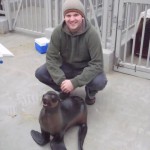Tel: 604.822.8181
Fax: 604.822.8180
E-mail: a.dalton@oceans.ubc.ca
Supervisor: Dr. Andrew Trites and Dr. David Rosen
Education: BSc – Marine and Freshwater Biology (University of Guelph, 2008)
Research Interests: Northern Fur Seals, Conservation and Recovery, Energetic Expenditure
Research Area: North Pacific Ocean and the Bering Sea
How much energy does it take to power a northern fur seal and what is the best way to measure that?
Problem
In April 2006, the northern fur seal (Callorhinus ursinus) was classified as “Threatened” under the Canadian Species at Risk Act. The northern fur seal, which inhabits the North Pacific Ocean, the Sea of Okhotsk, and the Bering Sea, is restricted to only six breeding colonies. The largest of these breeding co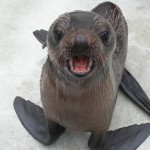 lonies, the Pribilof Islands in Alaska, is home to approximately 50% of the world’s northern fur seals. Unfortunately, this population declined significantly from 1956 to 1980 and began declining again in 1998. As of 2004, the population on the Pribilof Islands was declining at an average rate of 5.8% annually. Research suggests that the initial decline was likely due to commercial harvesting of females and scientific pelagic collections. However, the reason for the lack of population recovery following the cessation of those activities and the current decline remains elusive. One of the leading hypotheses for the decline in the Pribilof Islands is that fur seals are being outcompeted by commercial fisheries. This hypothesis asserts that commercial fisheries are putting fur seals in nutritional imbalance by removing some of their critical prey. Nutritional balance is determined by two key factors: the energetic requirements of the individual and its nutritional intake.
lonies, the Pribilof Islands in Alaska, is home to approximately 50% of the world’s northern fur seals. Unfortunately, this population declined significantly from 1956 to 1980 and began declining again in 1998. As of 2004, the population on the Pribilof Islands was declining at an average rate of 5.8% annually. Research suggests that the initial decline was likely due to commercial harvesting of females and scientific pelagic collections. However, the reason for the lack of population recovery following the cessation of those activities and the current decline remains elusive. One of the leading hypotheses for the decline in the Pribilof Islands is that fur seals are being outcompeted by commercial fisheries. This hypothesis asserts that commercial fisheries are putting fur seals in nutritional imbalance by removing some of their critical prey. Nutritional balance is determined by two key factors: the energetic requirements of the individual and its nutritional intake.
Research Questions
This study will focus on only the first key factor by addressing the following questions: 1) What is the daily energy expenditure of captive northern fur seals and does that change on a seasonal basis?, 2) What is the best method of measuring energy expenditure in northern fur seals? and 3) Are individual components of the northern fur seal’s energy budget (such as thermoregulation) changing on a seasonal basis?
Approach
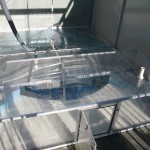 with 6 trained female northern fur seals housed at the Vancouver Aquarium, I am investigating what is the daily energy expenditure of the individuals and does that change over the course of 4 seasonal trials. The daily energy expenditure was measured using the “gold standard” respirometry or rates of oxygen consumption. A specially designed metabolic chamber was constructed to fit over one of the tanks and its associated haul-out area, providing the individual access to land and water during the trials and allowing the undertaking of the normal daily activities. Simultaneously over the course of these five day trials, Doubly Labeled Water (DLW), and accelerometers measuring partial Overall Dynamic Body Acceleration (ODBA), were measured as alternative measure of energy expenditure. Comparing each of the alternative methods to the “true” respirometric measure will permit the assessment of the accuracy of each method and there calibration for potential future application on wild individuals. This video: “Setup” will show you the assembly of the metabolic chamber and one of the northern fur seals swimming within it (the video is at a speed of 15X; it may take a second to load)
with 6 trained female northern fur seals housed at the Vancouver Aquarium, I am investigating what is the daily energy expenditure of the individuals and does that change over the course of 4 seasonal trials. The daily energy expenditure was measured using the “gold standard” respirometry or rates of oxygen consumption. A specially designed metabolic chamber was constructed to fit over one of the tanks and its associated haul-out area, providing the individual access to land and water during the trials and allowing the undertaking of the normal daily activities. Simultaneously over the course of these five day trials, Doubly Labeled Water (DLW), and accelerometers measuring partial Overall Dynamic Body Acceleration (ODBA), were measured as alternative measure of energy expenditure. Comparing each of the alternative methods to the “true” respirometric measure will permit the assessment of the accuracy of each method and there calibration for potential future application on wild individuals. This video: “Setup” will show you the assembly of the metabolic chamber and one of the northern fur seals swimming within it (the video is at a speed of 15X; it may take a second to load)
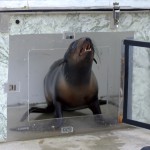 A second metabolic chamber was used to quantify the northern fur seal’s resting metabolic rate and cost of thermoregulation. This metabolic chamber was significantly smaller that the first and the fur seals were trained to enter the chamber, and remain calm while inside (and did so voluntarily). Once inside the chamber, rates of oxygen consumption were again measured, both in ambient air conditions, and at water temperatures between 2 and 18 °C.
A second metabolic chamber was used to quantify the northern fur seal’s resting metabolic rate and cost of thermoregulation. This metabolic chamber was significantly smaller that the first and the fur seals were trained to enter the chamber, and remain calm while inside (and did so voluntarily). Once inside the chamber, rates of oxygen consumption were again measured, both in ambient air conditions, and at water temperatures between 2 and 18 °C.
Preliminary Results
Using the small metabolic chamber, the ambient air metabolic rates of the female northern fur seals we studied changed 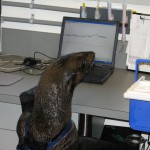 seasonally, but only in the fall due perhaps due to the added energetic expense of molting. The lack of metabolic responses to the thermal challenges we presented the fur seals indicates that they have an impressively wide thermal neutral zone. This wide TNZ is likely facilitated by a dense pelage in association with sebaceous glands and their secretions. Taken together, it allows fur seals to exploit the North Pacific Ocean across an extremely wide range of water temperatures during their annual pelagic migrations.
seasonally, but only in the fall due perhaps due to the added energetic expense of molting. The lack of metabolic responses to the thermal challenges we presented the fur seals indicates that they have an impressively wide thermal neutral zone. This wide TNZ is likely facilitated by a dense pelage in association with sebaceous glands and their secretions. Taken together, it allows fur seals to exploit the North Pacific Ocean across an extremely wide range of water temperatures during their annual pelagic migrations.
Publications
Fitzsimons, J.D., Bowen, K., Brousseau, C., Dalton, A., MacVeigh, B., Johnson, T.B. and Yuille, M. (2012) Round goby predation on Hemimysis anomala. Journal of Great Lakes Research. 38 (Supp. 2): 79 – 85.
Presentations
Dalton, A., Rosen, D.A.S., and Trites, A.W., Respirometry, Doubly Labelled Water Turnover and Accelerometry – Comparing their Accuracy and Applicability for Measuring Energy Expenditure in Northern Fur Seals. Society of Experimental Biology’s (SEB) 2012 Annual Meeting – Salzburg, Austria. (Oral presentation)
Dalton, A., Rosen, D.A.S., and Trites, A.W., I’m Not Cold, Am I? Thermoregulation in Northern Fur Seals. University of British Columbia’s Zoology Graduate Student Symposium 2012 – Vancouver, BC. (Oral presentation) and BC Marine Mammal Symposium 2011 – Vancouver, BC. (Oral presentation)
Dalton, A., Rosen, D.A.S., and Trites, A.W., Respirometry, and Accelerometry – Comparing their Accuracy and Applicability to Measure Energy Expenditure in Northern Fur Seals (Callorhinus ursinus). 19th Biennial Conference on the Biology of Marine Mammals 2011, Tampa, Florida (Poster presentation)
Dalton, A., Rosen, D.A.S., and Trites, A.W., How Much Energy Does it Take to Power a Northern Fur Seal (Callorhinus ursinus). BC Marine Mammal Symposium 2010 – Vancouver, BC. (Oral presentation)

